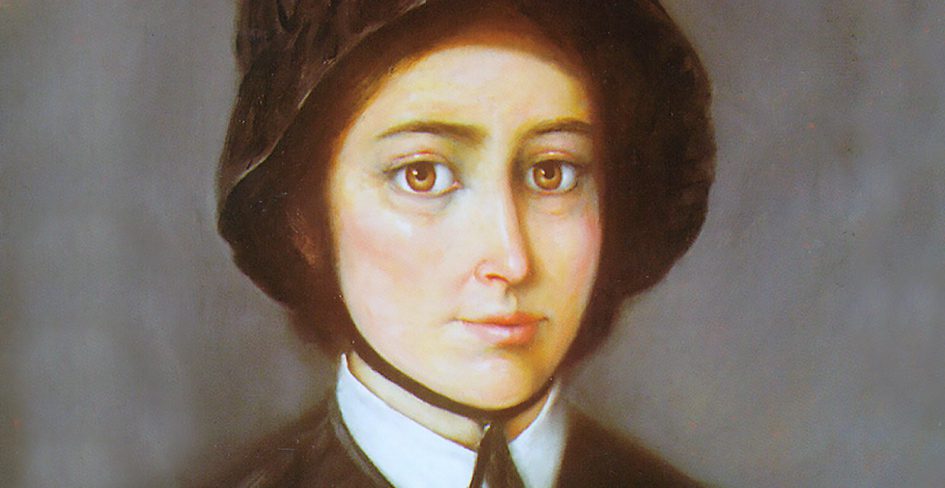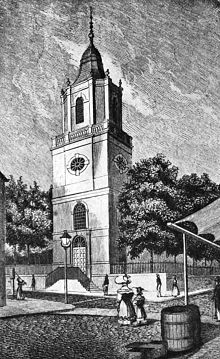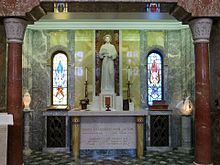Elizabeth Ann Seton is one of our favorite libertarian Catholics.
Born on August 28, 1774, the second child of a socially prominent couple, a surgeon, Dr. Richard Bayley and Catherine Charlton of New York City. The Bayley and Charlton families were among the earliest European settlers in the New York area.
Her mother, Catherine, died in 1777 when Elizabeth was three years old, possibly due to complications from the birth of her namesake Catherine, who died early the following year. Elizabeth’s father then married Charlotte Amelia Barclay, a member of the Jacobus James Roosevelt family to provide a mother for his two surviving daughters. The new Mrs. Bayley participated in her church’s social ministry, and often took young Elizabeth with her on charitable rounds, as she visited the poor in their homes to distribute food and needed items.
The couple had five children, but the marriage ended in separation. During the breakup, their stepmother rejected Elizabeth and her older sister. Their father then traveled to London for further medical studies, so the sisters lived temporarily in New Rochelle with their paternal uncle, William Bayley, and his wife, Sarah Pell Bayley. Elizabeth endured a time of darkness, grieving the absence of a second mother, as she later reflected in her journals. In these journals, Elizabeth showed her love for nature, poetry, and music, especially the piano. Other entries expressed her religious aspirations, and favorite passages from her reading showing her introspection and natural bent toward contemplation. Elizabeth was fluent in French, a fine musician, and an accomplished horsewoman.
Marriage and motherhood
On January 25, 1794, at age 19, Elizabeth married William Magee Seton, aged 25, a wealthy businessman in the import trade. Samuel Provoost, the first Episcopal bishop of New York, presided at their wedding. Shortly after they married, Elizabeth and William moved into a fashionable residence on Wall Street. Socially prominent in New York society, the Setons belonged to Trinity Episcopal Church, near Broadway and Wall Streets. A devout communicant, Elizabeth took the Rev. John Henry Hobart (later bishop) as her spiritual director. Along with her sister-in-law Rebecca Mary Seton (1780–1804) (her soul-friend and dearest confidante), Elizabeth continued her former stepmother’s social ministry—nursing the sick and dying among family, friends, and needy neighbors. Influenced by her father she became a charter member of The Society for the Relief of Poor Widows with Small Children (1797) and also served as the organization’s treasurer.
When the elder William Seton died, the Seton family fortunes waned during the volatile economic climate preceding the War of 1812. The couple took in William’s six younger siblings, ages seven to seventeen, in addition to their own five children: Anna Maria (Annina) (1795–1812), William II (1796–1868), Richard Seton (1798–1823), Catherine (1800–1891) (who was to become the first American to join the Sisters of Mercy) and Rebecca Mary (1802–1816).This necessitated a move to the larger Seton family residence.
Widowhood and conversion to Catholicism
A dispute between the United States of America and the French Republic from 1798 to 1800 led to a series of attacks on American shipping. The United Kingdom’s blockade of France and the loss of several of his ships at sea led William Seton into bankruptcy, and the Setons lost their home at 61 Stone Street in lower Manhattan. The following summer she and the children stayed with her father, who was still health officer for the Port of New York on Staten Island. From 1801 to 1803 they lived in a house at 8 State Street, on the site of the present Church of Our Lady of the Most Holy Rosary (built in 1964). Through most of their married life, William Seton suffered from tuberculosis. The stress worsened his illness; his doctors sent him to Italy for the warmer climate, with Elizabeth and their eldest daughter as his companions. Upon landing at the port of Leghorn, they were held in quarantine for a month, for authorities feared they might have brought yellow fever from New York. William died on December 27, 1803, and was buried in Italy’s Old English Cemetery. Elizabeth and Anna Maria were received by the families of her late husband’s Italian business partners, who introduced her to Roman Catholicism.
Returning to New York, the widow Seton was received into the Catholic Church on March 14, 1805, by the Reverend Matthew O’Brien, pastor of St. Peter’s Church,[then the city’s only Catholic church. (Anti-Catholic laws had been lifted just a few years before.) A year later, she received the sacrament of Confirmation from the Bishop of Baltimore, the Right Reverend John Carroll, the only Catholic bishop in the nation.
In order to support herself and her children, Seton had started an academy for young ladies, as was common for widows of social standing in that period. After news of her conversion to Catholicism spread, however, most parents withdrew their daughters from her tutelage. In 1807, students attending a local Protestant Academy were boarded at her house on Stuyvesant Lane in the Bowery, near St. Mark’s Church.
Seton was about to move to Canada when she met a visiting priest, the Abbé Louis William Valentine Dubourg, SS, who was a member of the French émigré community of Sulpician Fathers and then president of St. Mary’s College, Baltimore. The Sulpicians had taken refuge in the United States from the religious persecution of the Reign of Terror in France and were in the process of establishing the first Catholic seminary for the United States, in keeping with the goals of their society. For several years, Dubourg had envisioned a religious school to meet the educational needs of the new nation’s small Catholic community.
Founder
After living through many difficulties in life, in 1809 Seton accepted the invitation of the Sulpicians and moved to Emmitsburg, Maryland. A year later she established the Saint Joseph’s Academy and Free School, a school dedicated to the education of Catholic girls. This was possible due to the financial support of Samuel Sutherland Cooper, a wealthy convert and seminarian at the newly established Mount Saint Mary’s University, begun by John Dubois, S.S., and the Sulpicians.
On July 31, Seton established a religious community in Emmitsburg dedicated to the care of the children of the poor. This was the first congregation of religious sisters to be founded in the United States, and its school was the first free Catholic school in America. This modest beginning marked the start of the Catholic parochial school system in the United States. The congregation was initially called the Sisters of Charity of St. Joseph’s. From that point on, she became known as “Mother Seton”. In 1811, the sisters adopted the rules written by St. Vincent de Paul for the Daughters of Charity in France.
Later life and death
The remainder of Seton’s life was spent in leading and developing the new congregation. Seton was described as a charming and cultured lady. Her connections to New York society and the accompanying social pressures to leave the new life she had created for herself did not deter her from embracing her religious vocation and charitable mission. The greatest difficulties she faced were actually internal, stemming from misunderstandings, interpersonal conflicts and the deaths of two daughters, other loved ones, and young sisters in the community.
Seton died on January 4, 1821, at the age of 46. Today, her remains are entombed in the National Shrine of Saint Elizabeth Ann Seton in Emmitsburg, Maryland.
 The Libertarian Catholic
The Libertarian Catholic




